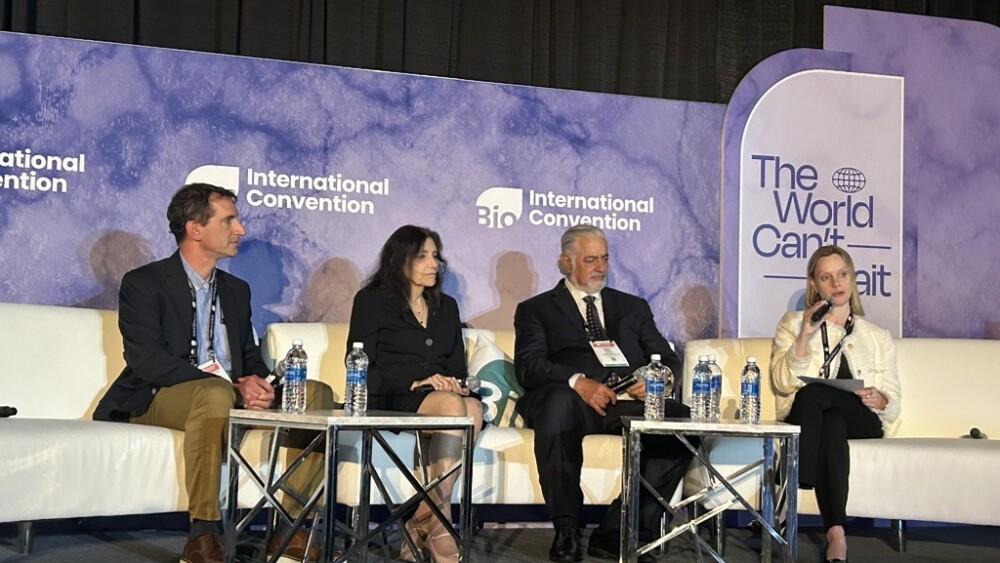Late breaking data examines 10-year cost effectiveness of fremanezumab, while one oral presentation and 29 posters highlight FOCUS Phase IIIb study data in adult patients with migraine and documented inadequate response to 2-4 classes of prior preventive treatments, along with patient survey results and post hoc efficacy results following the 1-year Phase III HALO long-term study
JERUSALEM--(BUSINESS WIRE)-- Teva Pharmaceuticals Industries Ltd. (NYSE and TASE: TEVA) today announced the Company will present more than 30 analyses on fremanezumab, at the 19th Congress of the International Headache Society (IHC), taking place in Dublin, Ireland on September 5-8, 2019. Teva will present late-breaking data evaluating the 10-year cost effectiveness of fremanezumab and post hoc subgroup analyses as well as secondary and exploratory endpoint data from the international, multicentre, randomised, placebo-controlled Phase IIIb FOCUS study. This study evaluated the efficacy and safety of quarterly and monthly treatment with fremanezumab compared to placebo in adult patients with migraine and documented inadequate response to 2-4 classes of prior preventive migraine treatments. Also being presented are five posters based on a patient survey following the one-year Phase III HALO long-term study that examined the impact of fremanezumab on functioning and productivity in migraine patients. The presentation of data at this congress follows the publication of FOCUS study data in The Lancet last month.
“Migraine is one of the most prevalent diseases in the world, with more than 1 billion people living with it globally,”1 said Joshua M. Cohen, MD, MPH, FAHS, Global Medical Lead for Migraine & Headache, Teva. “We are committed to studying this burdensome disease and strive to lead the way in migraine research. We are proud to share a broad range of new fremanezumab data at this year’s IHC from, amongst others, the largest study to date in patients who have responded inadequately to 2-4 classes of prior preventive migraine treatments.”
The FOCUS data analyses at IHC evaluated onset of action, medication overuse, depression, quality of life, and reversion from chronic to episodic migraine, and demonstrated a significant reduction in the number of headache hours and days, and migraine days, suffered by difficult-to-treat patients with migraine when treated with monthly or quarterly fremanezumab, compared to placebo. The most common adverse events included injection site reactions. A patient survey following the one-year Phase III HALO long-term study evaluated patient satisfaction with fremanezumab treatment, and impact on quality of life, and patient preferences for dosing regimens in the preventive treatment of migraine.
Below is a selection of accepted abstracts being presented at IHC 2019:
Later Breaking Data:
- [IHC-LB-006] Burden of comorbid depression and anxiety on migraine-specific health-related quality of life in adult migraine patients in the United States (September 6, 2019, 11 – 12pm IST)
- [IHC-LB-030] 10-year cost-effectiveness analyses of response-based fremanezumab use in migraine patients with inadequate response to prior preventive treatments (September 6, 2019, 11 – 12pm IST)
- [IHC-LB-037] 10-year cost-effectiveness analyses of fremanezumab compared to erenumab as preventive treatment in episodic migraine for patients with inadequate response to prior preventive treatments (September 6, 2019, 11 – 12pm IST)
- [IHC-OR-040] (de novo): Efficacy and safety of fremanezumab for the prevention of episodic cluster headache: results of a randomized, double-blind, placebo-controlled, phase 3 study (September 8, 2019, 8:20am IST)
Oral Presentation:
- [IHC-OR-012] Very early onset* of action of fremanezumab in patients with migraine and documented inadequate response to 2-4 classes of migraine preventive treatments: results of the international, multicentre, randomised, placebo-controlled FOCUS study (September 7, 2019, 10:30am IST)
Poster Presentations:
- [IHC-PO-138] Efficacy with fremanezumab in migraine patients with comorbid moderate to severe depression and documented inadequate response to 2-4 classes of migraine preventive treatments: subgroup analysis of the randomised, placebo-controlled FOCUS study(September 6, 2019, 11 – 12pm IST)
- [IHC-PO-137] Early onset* of response to fremanezumab in migraine patients with moderate to severe depression and documented inadequate response to 2-4 classes of migraine preventive treatments: subgroup analysis of the randomised, placebo-controlled FOCUS study (September 6, 2019, 11 – 12pm IST)
- [IHC-PO-156] Efficacy of fremanezumab in migraine patients with medication overuse and documented inadequate response to 2-4 migraine preventive medications: subgroup analysis of the randomised, placebo-controlled FOCUS study (September 6, 2019, 11 – 12pm IST)
- [IHC-PO-148] Impact of fremanezumab on disability in migraine patients with medication overuse and documented inadequate response to 2-4 classes of preventive treatments: subgroup analysis of the randomised, double-blind FOCUS study (September 6, 2019, 11 – 12pm IST)
- [IHC-PO-149] Impact of fremanezumab on migraine-specific quality of life in patients with medication overuse and documented inadequate response to 2-4 classes of migraine preventive treatments: subgroup analysis of the international, multicentre, randomised, double-blind FOCUS study (September 6, 2019, 11 – 12pm IST)
- [IHC-PO-150] Early onset* of efficacy with fremanezumab in patients with medication overuse and documented inadequate response to 2-4 classes of migraine preventive treatments: subgroup analysis of the randomised, double-blind FOCUS study (September 6, 2019, 11 – 12pm IST)
- [IHC-PO-157] Clinically meaningful responses to fremanezumab in migraine patients with medication overuse and documented inadequate response to 2-4 migraine preventive medications in the randomised, placebo-controlled FOCUS study (September 6, 2019, 11 – 12pm IST)
- [IHC-PO-171] A pharmacokinetic bioequivalence study of fremanezumab administered subcutaneously using an autoinjector and a prefilled syringe (September 6, 2019, 11 – 12pm IST)
- [IHC-PO-172] Impact of fremanezumab on any acute headache medication use in migraine patients with medication overuse and documented inadequate response to 2-4 migraine preventive medications in the multicentre, randomised, placebo-controlled FOCUS study(September 6, 2019, 11 – 12pm IST)
- [IHC-PO-151] Reversion from chronic to episodic migraine in patients with documented inadequate response to 2-4 classes of migraine preventive treatments: results of the randomised, placebo-controlled FOCUS study (September 6, 2019, 11 – 12pm IST)
- [IHC-PO-384] Efficacy of fremanezumab in male patients with migraine and documented inadequate response to 2-4 classes of migraine preventive treatments: results of the randomised, placebo-controlled FOCUS study (September 7, 14:45 – 15:45pm IST)
- [IHC-PO-404] Patient preference and satisfaction following completion of a 1-year extension study (September 7, 14:45 – 15:45pm IST)
- [IHC-PO-388] Functioning and productivity impact of fremanezumab in migraine patients: a patient survey study following completion of a 1-year extension study (September 7, 14:45 – 15:45pm IST)
*Early onset of efficacy (efficacy measures: reduction in migraine days, reduction in headache days, response rate) is defined as week one following treatment initiation.
About FOCUS
The Phase IIIb FOCUS study is a multicentre, randomised, double-blind, parallel-group, placebo-controlled study that evaluated the efficacy, safety, and tolerability of quarterly and monthly treatment with fremanezumab, compared to placebo. Adult patients with chronic migraine or episodic migraine who have responded inadequately to 2-4 classes of prior preventive treatments were enrolled in the study.
Inadequate response is defined as: lack of efficacy after at least three months of therapy at a stable dose; or the patient cannot tolerate the drug; or the drug is contraindicated; or the drug is not suitable for the patient. The classes of prior preventive medications include: beta-blockers, anticonvulsants, tricyclics, calcium channel blockers, angiotensin II receptor antagonists, onabotulinumtoxinA, and valproic acid.
In the study, chronic migraine and episodic migraine patients were randomised in blinded-fashion 1:1:1 into one of three treatment groups – a quarterly dosing regimen, a monthly dosing regimen or matching placebo. An open-label extension of three months (weeks 13-24) followed the placebo-controlled portion of the study.
About the HALO Clinical Research Program
The Phase III HALO EM and CM studies were 16-week, multicentre, randomised, double-blind, placebo-controlled, parallel-group studies to compare the safety, tolerability, and efficacy of four dose regimens (two for EM [quarterly and monthly] and two for CM [quarterly and monthly]), of subcutaneous fremanezumab compared to placebo in adults with episodic and chronic migraine. The studies consisted of a screening visit, a 28-day run-in period, and a 12-week (84-day) treatment period, including a final evaluation at week 12 (end-of-treatment [EOT] visit, four weeks [28 days] after the final dose of study drug).
- In the EM study, 875 patients were enrolled (294, 291, 290 patients in the placebo, quarterly, and monthly dose groups, respectively). Patients were randomised in a 1:1:1 ratio to receive subcutaneous injections of fremanezumab at 225 mg for three months (monthly dose regimen), fremanezumab at 675 mg at initiation followed by placebo for two months (quarterly dose regimen), or three monthly doses of matching placebo. The primary efficacy endpoint of the EM study was the mean change from baseline (28-day run-in period) in the monthly average number of migraine days during the 12-week period after the first dose of fremanezumab.
- In the CM study, 1,130 patients were randomised (375, 376, 379 patients in the placebo, quarterly, and monthly groups, respectively). Patients were randomised in a 1:1:1 ratio to receive subcutaneous injections of fremanezumab at 675 mg at initiation followed by monthly 225 mg for two months (monthly dose regimen), fremanezumab at 675 mg at initiation followed by placebo for two months (quarterly dose regimen), or three monthly doses of matching placebo. The primary efficacy endpoint of the CM study was the mean change from baseline (28-day run-in period) in the monthly average number of headache days of at least moderate severity during the 12-week period after the first dose of fremanezumab.
U.S. Important Safety Information about AJOVY® (fremanezumab)
Contraindications: AJOVY is contraindicated in patients with serious hypersensitivity to fremanezumab-vfrm or to any of the excipients.
Hypersensitivity Reactions: Hypersensitivity reactions, including rash, pruritus, drug hypersensitivity, and urticaria were reported with AJOVY in clinical trials. Most reactions were mild to moderate, but some led to discontinuation or required corticosteroid treatment. Most reactions were reported from within hours to one month after administration. If a hypersensitivity reaction occurs, consider discontinuing AJOVY and institute appropriate therapy.
Adverse Reactions: The most common adverse reactions (≥5% and greater than placebo) were injection site reactions.
Please click here for full U.S. Prescribing Information for AJOVY® (fremanezumab-vfrm) injection.
Information for Europe about AJOVY®■ can be found here.
In the EU, AJOVY is indicated for prophylaxis of migraine in adults who have at least 4 migraine days per month
■Adverse events should be reported.
This medicinal product is subject to additional monitoring. This will allow quick identification of new safety information. Healthcare professionals are asked to report any suspected adverse events.
Reporting forms and information can be found at https://www.hpra.ie. Adverse events should also be reported to Teva – please refer to local numbers.
About Teva
Teva Pharmaceutical Industries Ltd. (NYSE and TASE: TEVA) has been developing and producing medicines to improve people’s lives for more than a century. We are a global leader in generic and specialty medicines with a portfolio consisting of over 2,400 products in nearly every therapeutic area. Around 200 million people around the world take a Teva medicine every day, and are served by one of the largest and most complex supply chains in the pharmaceutical industry. Along with our established presence in generics, we have significant innovative research and operations supporting our growing portfolio of specialty and biopharmaceutical products. Learn more at www.tevapharm.com.
Cautionary Note Regarding Forward-Looking Statements
This press release contains forward-looking statements within the meaning of the Private Securities Litigation Reform Act of 1995 regarding fremanezumab, which are based on management’s current beliefs and expectations and are subject to substantial risks and uncertainties, both known and unknown, that could cause our future results, performance or achievements to differ significantly from that expressed or implied by such forward-looking statements. Important factors that could cause or contribute to such differences include risks relating to:
- challenges inherent in product research and development, including uncertainty of clinical success and obtaining regulatory approvals;
- our ability to successfully compete in the marketplace, including: that we are substantially dependent on our generic products; competition for our specialty products, especially COPAXONE®, our leading medicine, which faces competition from existing and potential additional generic versions and orally-administered alternatives; the uncertainty of commercial success of AJOVY® or AUSTEDO®; competition from companies with greater resources and capabilities; efforts of pharmaceutical companies to limit the use of generics, including through legislation and regulations; consolidation of our customer base and commercial alliances among our customers; the increase in the number of competitors targeting generic opportunities and seeking U.S. market exclusivity for generic versions of significant products; price erosion relating to our products, both from competing products and increased regulation; delays in launches of new products and our ability to achieve expected results from investments in our product pipeline; our ability to take advantage of high-value opportunities; the difficulty and expense of obtaining licenses to proprietary technologies; and the effectiveness of our patents and other measures to protect our intellectual property rights
- our substantial indebtedness, which may limit our ability to incur additional indebtedness, engage in additional transactions or make new investments, may result in a further downgrade of our credit ratings; and our inability to raise debt or borrow funds in amounts or on terms that are favorable to us;
- our business and operations in general, including: failure to effectively execute our restructuring plan announced in December 2017; uncertainties related to, and failure to achieve, the potential benefits and success of our senior management team and organizational structure; harm to our pipeline of future products due to the ongoing review of our R&D programs; our ability to develop and commercialize additional pharmaceutical products; potential additional adverse consequences following our resolution with the U.S. government of our FCPA investigation; compliance with sanctions and other trade control laws; manufacturing or quality control problems, which may damage our reputation for quality production and require costly remediation; interruptions in our supply chain; disruptions of our or third party information technology systems or breaches of our data security; the failure to recruit or retain key personnel; variations in intellectual property laws that may adversely affect our ability to manufacture our products; challenges associated with conducting business globally, including adverse effects of political or economic instability, major hostilities or terrorism; significant sales to a limited number of customers in our U.S. market; our ability to successfully bid for suitable acquisition targets or licensing opportunities, or to consummate and integrate acquisitions; implementation of a new enterprise resource planning system that, if deficient, could materially and adversely affect our operations and/or the effectiveness of our internal controls; and our prospects and opportunities for growth if we sell assets;
- compliance, regulatory and litigation matters, including: costs and delays resulting from the extensive governmental regulation to which we are subject; the effects of reforms in healthcare regulation and reductions in pharmaceutical pricing, reimbursement and coverage; increased legal and regulatory action in connection with public concern over the abuse of opioid medications in the U.S.; governmental investigations into selling and marketing practices; potential liability for patent infringement; product liability claims; increased government scrutiny of our patent settlement agreements; failure to comply with complex Medicare and Medicaid reporting and payment obligations; and environmental risks;
- other financial and economic risks, including: our exposure to currency fluctuations and restrictions as well as credit risks; potential impairments of our intangible assets; potential significant increases in tax liabilities; and the effect on our overall effective tax rate of the termination or expiration of governmental programs or tax benefits, or of a change in our business;
and other factors discussed in our Quarterly Reports on Form 10-Q for the first and second quarter of 2019 and in our Annual Report on Form 10-K for the year ended December 31, 2018, including in the sections captioned "Risk Factors” and “Forward Looking Statements.” Forward-looking statements speak only as of the date on which they are made, and we assume no obligation to update or revise any forward-looking statements or other information contained herein, whether as a result of new information, future events or otherwise. You are cautioned not to put undue reliance on these forward-looking statements.
References
- GBD 2016 Disease and Injury Incidence and Prevalence Collaborators. Global, regional, and national incidence, prevalence, and years lived with disability for 328 diseases and injuries for 195 countries, 1990‐2016: a systematic analysis for the Global Burden of Disease Study 2016. Lancet. 2017;390:1211‐1259
View source version on businesswire.com: https://www.businesswire.com/news/home/20190903005351/en/
Contacts
IR Contacts
United States
Kevin C. Mannix (215) 591-8912
Ran Meir 972 (3) 926-7516
PR Contacts
United States
Doris Saltkill (913) 777-3343
Israel
Yonatan Beker 972 (54) 888 5898
Source: Teva Pharmaceutical Industries Ltd.






